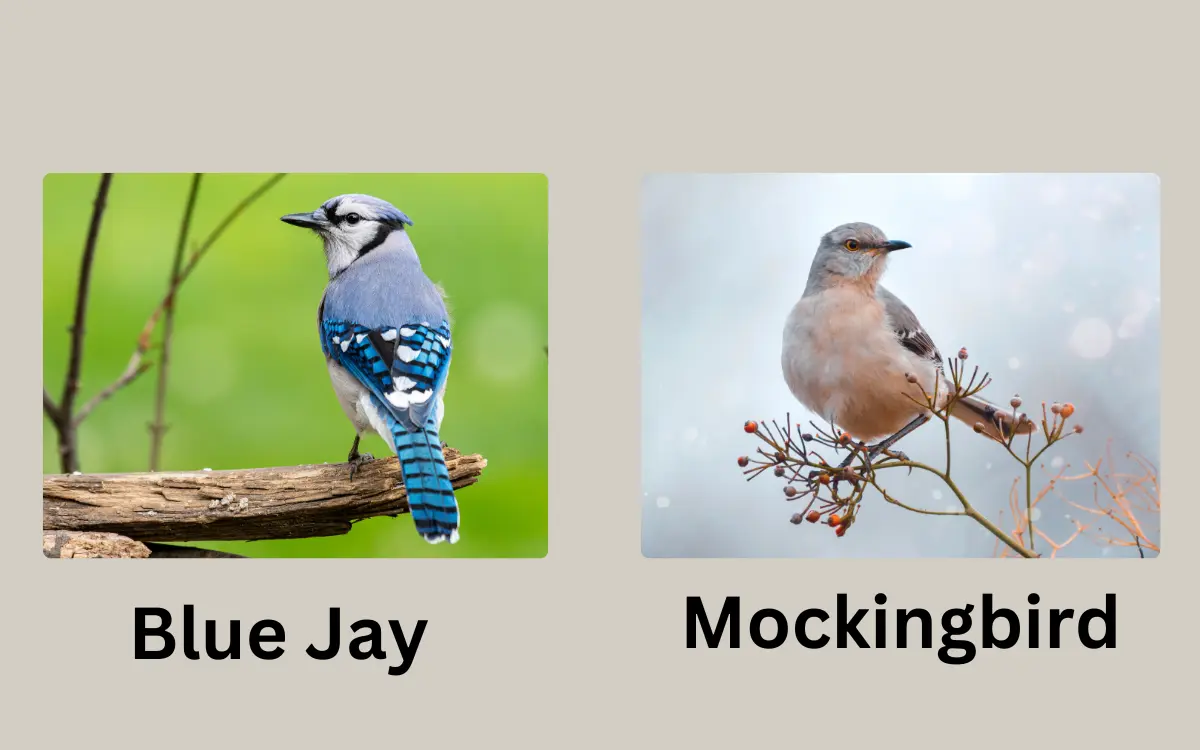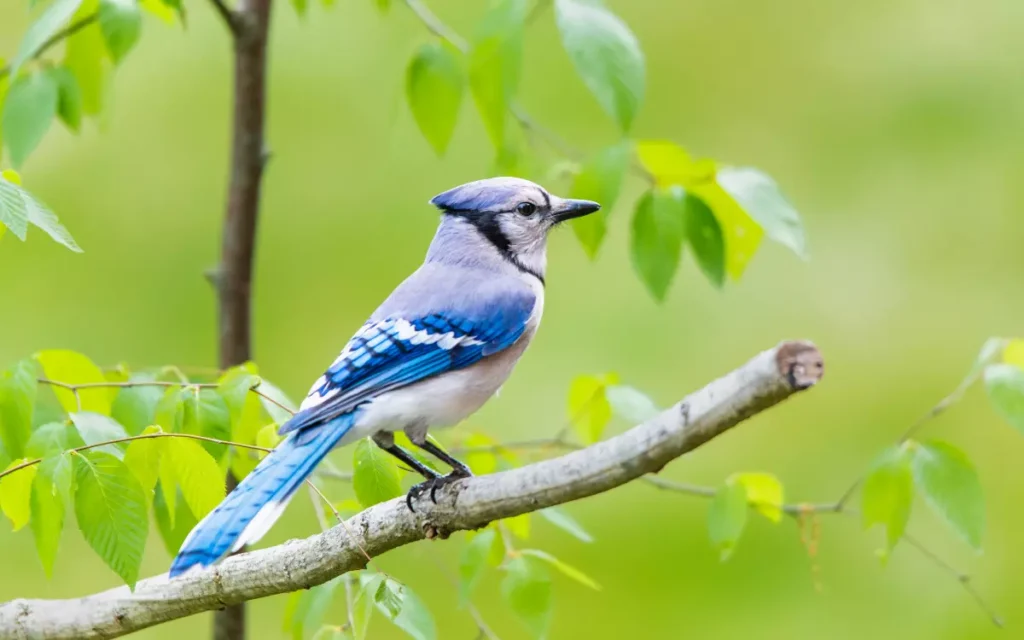Blue Jay vs Mockingbird: Difference

Here we discuss all about Blue Jay vs Mockingbird. Below we have created a great table that will give you all the information about these two birds in one table.
Differences Between Blue Jay vs Mockingbird :
| Feature | Blue Jay | Mockingbird |
| Vocalization | Variety of calls, can mimic hawks | Mimics other birds, animals, and sounds |
| Coloration | Blue, white, and black plumage | Mostly gray with white patches |
| Feeding Habits | Omnivorous, eats insects, seeds, nuts | Insectivorous, also eats fruits and seeds |
| Nesting Preferences | Trees, 10-25 feet above ground | Shrubs or low trees |
| Nesting Material | Twigs, grass, and mud, lined with rootlets | Twigs, leaves, and trash |
| Territorial Behavior | Aggressive, especially during breeding season | Highly territorial, aggressive to intruders |
| Migration Patterns | Partial migrant, depending on region | Mostly resident, limited migration |
| Behavior in Winter | Forms flocks, visits feeders | Remains territorial, less vocal |
| Social Behavior | Social, forms family groups | Solitary or in pairs |
| Song Complexity | Limited song, mostly calls | Highly complex songs, extensive repertoire |
| Eating Preferences | Varied diet, includes nuts and grains | Prefers insects, also eats fruits |
| Size | Larger, about 10-12 inches | Smaller, about 8-10 inches |
| Range | Eastern and central North America | Southern and eastern North America |
| Nesting Season | Spring to early summer | Spring to late summer |
| Egg Color | Bluish or light brown with spots | Pale blue to greenish with spots |
| Parental Care | Both parents feed nestlings | Both parents feed and protect nestlings |
| Mobility | Agile flyers, can hover | Quick, darting flight |
| Intelligence | Highly intelligent, uses tools | Intelligent, adapts to environments |
| Predator Imitation | Mimics hawk calls to deter predators | Does not mimic predators |
| Winter Adaptations | Forms large flocks, migrates south | Stays in territory, less active |
| Urban Adaptability | Adapts well to urban environments | Adapts well to urban and suburban areas |
| Egg Clutch Size | 2-7 eggs | 2-6 eggs |
| Lifespan | Up to 7 years in the wild | Up to 8 years in the wild |
Physical Characteristics of Blue Jays and Mockingbirds:
Blue Jays are beautiful birds known for their striking blue, white, and black feathers. They are medium-sized birds, usually measuring 10-12 inches in length.
One of their most distinctive features is their crested head, which they can raise or lower depending on their mood. They also have a strong, black bill and bright blue wings with white and black markings.
Mockingbirds, on the other hand, are known for their gray color with some white patches on their wings and tail. They are smaller than Blue Jays, typically measuring 8-10 inches in length.
Mockingbirds have a slim build, a long tail, and a thin, pointed bill. They don’t have a crest like the Blue Jays, but their sleek, gray appearance is quite distinctive in its own right.
Do you know there are similler birds that look like Blue jays
Habitat and Range:

Blue Jays live in forests, parks, and gardens in the eastern and central parts of North America. They like places with lots of trees and shrubs.
Some Blue Jays move south in the winter, but many stay in the same area all year.
Mockingbirds are found in the southern and eastern parts of North America. They can live in many places, like open areas, suburbs, parks, and even deserts. Mockingbirds usually stay in the same place all year, but some might travel south in the winter.
Both birds are common where people live, so you might see them in your backyard!
Behavior and Communication:
Blue Jays are social birds that form strong family bonds. They often stay with their family throughout the year. They are known for their loud calls and can also mimic other birds’ sounds.
Mockingbirds are famous for their singing skills. They can copy the sounds of other birds and use their songs to protect their territory. They are very territorial and will defend their area from other birds.
When it comes to flying, Blue Jays have a strong, steady flight, while Mockingbirds fly with a series of quick flaps and glides.
Read also:-Blue Jay Spiritual Meaning: Symbolism and Love Revealed
Breeding and Nesting:

Blue Jays have their breeding season in spring to early summer. They build nests in trees using twigs and grass.
Their eggs incubate for about 17-18 days, and the baby birds (nestlings) stay in the nest for 17-21 days before they can fly.
Mockingbirds also breed in spring to late summer. They make nests in bushes or low trees with twigs and leaves.
Their eggs incubate for about 12-13 days, and the nestlings stay in the nest for about 12 days before they can fly.
Diet and Feeding Habits:
Blue Jays have an omnivorous diet, which means they eat both plants and animals. They love to eat nuts, seeds, fruits, and insects.
Blue Jays are known for their smart way of eating acorns by holding them with their feet and pecking them open.
Mockingbirds mainly eat insects, like beetles and ants, but they also enjoy fruits and berries. They are good at catching insects in the air or finding them on the ground.
Both birds have different food preferences, but they are good at finding food in their environments.
Interactions with Other Birds and Animals:
Blue Jays can mimic hawk calls to scare other birds. They also interact with birds like cardinals at feeders.
Mockingbirds can copy many sounds and are very territorial. Their actions can change how other birds behave in the ecosystem.
Learning about bird interactions, like robin vs blue jay, can be interesting.
Conservation and Coexistence:
The Blue Jay and Northern Mockingbird are both considered species of Least Concern by the IUCN Red List.
They are protected under the US Migratory Bird Act and thrive in various habitats, including urban areas.
Conservation efforts focus on habitat preservation and mitigating threats like predation by cats and window collisions.
Programs like the American Bird Conservancy’s Cats Indoors and Glass Collisions aim to promote coexistence between these birds and humans.
For more information, visit American Bird Conservancy and Animal Diversity Web.
FAQS:
1. What is the difference between a mockingbird and a blue jay?
Ans: Mockingbirds are mostly gray and known for their ability to mimic other birds’ songs, while Blue Jays are blue, white, and black, and are known for their loud calls and intelligence.
2. Can mockingbirds mimic blue jays?
Ans: Yes, mockingbirds can mimic the calls of blue jays, along with many other sounds and bird songs.
3. What bird is the enemy of the Blue Jay?
Ans: Blue Jays don’t have a specific “enemy” bird, but they can be aggressive towards other birds, especially during nesting season. Hawks and owls may prey on Blue Jays.
4. What does Atticus say about blue jays?
Ans: In “To Kill a Mockingbird,” Atticus Finch says, “Shoot all the bluejays you want, if you can hit ’em, but remember it’s a sin to kill a mockingbird.”
5. What does a mockingbird symbolize?
Ans: A mockingbird symbolizes innocence and the importance of protecting those who do no harm, as seen in “To Kill a Mockingbird” by Harper Lee.
6. Why is Atticus a mockingbird?
Ans: In “To Kill a Mockingbird,” Atticus Finch is considered a “mockingbird” because he represents goodness and the moral principle of defending the innocent, similar to how the bird is seen as a symbol of innocence.
Conclusion:
both the Blue Jay and Mockingbird are fascinating birds with unique traits and behaviors. Understanding the differences between them, such as their vocalizations, diet, and nesting habits, can enhance our appreciation for these remarkable creatures and their roles in nature and culture.






